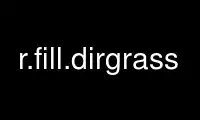
This is the command r.fill.dirgrass that can be run in the OnWorks free hosting provider using one of our multiple free online workstations such as Ubuntu Online, Fedora Online, Windows online emulator or MAC OS online emulator
PROGRAM:
NAME
r.fill.dir - Filters and generates a depressionless elevation map and a flow direction
map from a given elevation raster map.
KEYWORDS
raster, hydrology
SYNOPSIS
r.fill.dir
r.fill.dir --help
r.fill.dir [-f] input=name output=name direction=name [areas=name] [format=string]
[--overwrite] [--help] [--verbose] [--quiet] [--ui]
Flags:
-f
Find unresolved areas only
--overwrite
Allow output files to overwrite existing files
--help
Print usage summary
--verbose
Verbose module output
--quiet
Quiet module output
--ui
Force launching GUI dialog
Parameters:
input=name [required]
Name of input elevation raster map
output=name [required]
Name for output depressionless elevation raster map
direction=name [required]
Name for output flow direction map for depressionless elevation raster map
areas=name
Name for output raster map of problem areas
format=string
Aspect direction format
Options: agnps, answers, grass
Default: grass
DESCRIPTION
r.fill.dir filters and generates a depressionless elevation map and a flow direction map
from a given raster elevation map.
NOTES
The format parameter is the type of format at which the user wishes to create the flow
direction map. The agnps format gives category values from 1-8, with 1 facing north and
increasing values in the clockwise direction. The answers format gives category values
from 0-360 degrees, with 0 (360) facing east and values increasing in the counter
clockwise direction at 45 degree increments. The grass format gives the same category
values as the r.slope.aspect program.
The method adopted to filter the elevation map and rectify it is based on the paper titled
"Software Tools to Extract Structure from Digital Elevation Data for Geographic
Information System Analysis" by S.K. Jenson and J.O. Domingue (1988).
The procedure takes an elevation layer as input and initially fills all the depressions
with one pass across the layer. Next, the flow direction algorithm tries to find a unique
direction for each cell. If the watershed program detects areas with pothholes, it
delineates this area from the rest of the area and once again the depressions are filled
using the neighborhood technique used by the flow direction routine. The final output will
be a depressionless elevation layer and a unique flow direction layer.
This (D8) flow algorithm performs as follows: At each raster cell the code determines the
slope to each of the 8 surrounding cells and assigns the flow direction to the highest
slope out of the cell. If there is more than one equal, non-zero slope then the code
picks one direction based on preferences that are hard-coded into the program. If the
highest slope is flat and in more than one direction then the code first tries to select
an alternative based on flow directions in the adjacent cells. r.fill.dir iteratates that
process, effectively propagating flow directions from areas where the directions are known
into the area where the flow direction can’t otherwise be resolved.
The flow direction map can be encoded in either ANSWERS (Beasley et.al, 1982) or AGNPS
(Young et.al, 1985) form, so that it can be readily used as input to these hydrologic
models. The resulting depressionless elevation layer can further be manipulated for
deriving slopes and other attributes required by the hydrologic models.
In case of local problems, those unfilled areas can be stored optionally. Each unfilled
area in this maps is numbered. The -f flag instructs the program to fill single-cell pits
but otherwise to just find the undrained areas and exit. With the -f flag set the program
writes an elevation map with just single-cell pits filled, a direction map with unresolved
problems and a map of the undrained areas that were found but not filled. This option was
included because filling DEMs was often not the best way to solve a drainage problem.
These options let the user get a partially-fixed elevation map, identify the remaining
problems and fix the problems appropriately.
r.fill.dir is sensitive to the current window setting. Thus the program can be used to
generate a flow direction map for any sub-area within the full map layer. Also, r.fill.dir
is sensitive to any mask in effect.
In some cases it may be necessary to run r.fill.dir repeatedly (using output from one run
as input to the next run) before all of problem areas are filled.
EXAMPLE
r.fill.dir input=ansi.elev output=ansi.fill.elev direction=ansi.asp
Will create a depressionless (sinkless) elevation map ansi.fill.elev and a flow direction
map ansi.asp for the type "grass".
REFERENCES
· Beasley, D.B. and L.F. Huggins. 1982. ANSWERS (areal nonpoint source watershed
environmental response simulation): User’s manual. U.S. EPA-905/9-82-001, Chicago,
IL, 54 p.
· Jenson, S.K., and J.O. Domingue. 1988. Extracting topographic structure from
digital elevation model data for geographic information system analysis.
Photogram. Engr. and Remote Sens. 54: 1593-1600.
· Young, R.A., C.A. Onstad, D.D. Bosch and W.P. Anderson. 1985. Agricultural
nonpoint surface pollution models (AGNPS) I and II model documentation. St. Paul:
Minn. Pollution control Agency and Washington D.C., USDA-Agricultural Research
Service.
Use r.fill.dirgrass online using onworks.net services
